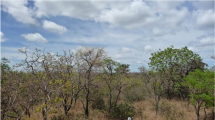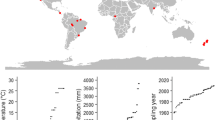Abstract
Paleoecological and geomorphological studies indicate that, during the middle Holocene, there was a predominance of drier conditions with grassy savannahs replacing forests across the South American continent. Modern savannahs are composed mainly of C4 plants and soils developed under this type of vegetation show enrichment in 13C compared to soils under C3 vegetation cover. If soils contain stabilized organic matter formed in the middle Holocene, we hypothesize that former C4 vegetation would be evidenced by a large enrichment of 13C in soil organic matter (SOM). We investigate this possibility examining the depth variation of carbon isotopic composition in 21 soil profiles collected by different researchers at 14 different sites in Brazil. Of these, profiles from only three sites showed a marked increase of 13C with depth (9–10‰ enrichment in δ13C difference between the surface soil and deepest depth); two sites showed intermediate enrichment (4–5‰), and nine sites showed a small enrichment of approximatelly 2.5‰. The majority of sites showing all-C3 derived SOM were in the Amazon region. Possible causes for the absence of a large 13C enrichment with depth are: (1) dominance of C3 rather than C4 grasses in mid-Holocene savannahas, (2) soil profiles did not preserve organic matter derived from mid-Holocene plants, (3) the retreat of forest areas did not occur on a regional scale, but was a much more localized phenomenon.
Similar content being viewed by others
References
Ab'Saber AN (1982) The paleoclimate and paleoecology of brazilian Amazon. In: Prance GT (ed) Biological diversification in the tropics. Columbia University Press, New York, pp 41–59
Absy ML (1980) Dados sobre as mudanças do clima e da vegetação da Amazônia durante o Quaternário. Acta Amazonica 10:929–932
Absy ML, Van der Hammen T (1976) Some paleo-ecological data from Rondônia, southern part of Amazonian Basin. Acta Amazonica 6:293–299
Absy ML, Cleef A, Fournier M, Martin L, Servant M, Sifeddine A, Ferreira da Silva M, Soubies F, Suguio K, Turcq B, Van der Hammen T (1991) Mise en évidence de quatre phases d'ouverture de la forêt dense dans le sud-est de l'Amazonie au cours des 60000 dernières année. Première comparaison avec d'autres régions tropicales. CR Acad Sci Paris Sér II 312:673–678
Adámoli JM (1982) O Pantanal e suas relações fiotogeográficas com os cerrados. Discussão sobre o conceito “Complexo Pantanal”. In: Proceedings of Congresso Brasileiro de Botânica. Sociedade Brasileira de Botânica, Teresina, Brazii, pp 109–119
Bigarella JJ, Andrade-Lima D (1982) Paleoenvironmental changes in Brazil. In: Prance GT (ed) Biological diversification in the tropics. Columbia University Press, New York, pp 27–40
Boulet R, Pessenda LCR, Telles ECC, Melfi AJ (1995) Une évaluation de la vitesse de l'accumulation superficielle de matière par la faune du sol à partir de la datation des charbons et de l'humine du sol. Exemple des latosols des versants du lac Campestre, Salitre, Minas Gerais, Brésil. CR Acad Sci Paris Ser IIa 320:287–294
Brown KS Jr (1974) Quaternary refugia in tropical America: evidence for race formation in Heliconius batterflies. Proc R Soc Lond B 187:369–378
Bush M, Colinvaux PA (1990) A pollen record of a complete glacial cycle from lowland Panama. J Veg Sci 1:105–118
Bush MB, Colinvaux PA, Wiemann C, Piperno DR, Liu KB (1990) Late Pleistocene temperature depression and vegetation change in Ecuadorian Amazonia. Quat Res 34:330–345
Cerri C (1979) Alteração e pedogênese em áreas graníticas situadas sob differentes condições bioclimáticas encontradas no Brasil. Master Thesis, University of São Paulo
Desjardins Th, Volkoff B, Andreux F, Cerri C (1991) Distribution du carbone total et de l'isotope 13C dans des sols ferralitiques du Brésil. Sci Sol 29:175–187
Dzurec RS, Boutton TW, Caldwell MM, Smith BN (1985) Carbon isotope ratios of soil organic mattern and their use in assessing community composition changes in Curlew Valley, Utah. Oecologia 66:17–24
Guillet B, Faivre P, Mariotti A, Khobzi J (1988) The 14C dates and 13C/12C ratios of soil organic matter as a means of studying the past vegetation in intertropical regions: examples from Cólombia (South America). Palaeogeogr Palaeoclim Palaeoecol 65:51–58
Haffer J (1969) Speciation in Amazonian forest birds. Science 165:131–137
Higa NT (1989) Caracterização das fases sólida e líquida de solos e arenas derivados do granito sob floresta tropical Amazônica (Terra Nova do Norte-MT). Ph D Thesis, University of São Paulo
Jenkinson DS, Adams DE, Wild A (1991) Model estimates of CO2 emissions from soil in response to global warming. Nature 351:304–306
Ledru MP (1992) Modifications de la végétation du Brésil Central entre la dernière époque glaciaire et l'interglaciaire actuel. CR Acad Sci Paris Ser II 314:117–123
Ledru MP (1993) Late Quaternary environmental and climatic changes in central Brazil. Quat Res 39:90–98
Leyden BW (1985) Late Quaternary aridity and holocene moisture fluctuations in the Lake Valencia basin, Venezuela. Ecology 66:1279–1295
Mariotti A, Petershmitt E (1994) Forest savanna ecotone dynamics in India as revealed by carbon isotope ratios of soil organic matter. Oecologia 97:475–480
Markgraf V (1989) Paleoclimates in Central and South America since 18.000 BP based on pollen and lake-level records. Quat Sci Rev 8:1–24
Markgraf V (1991) Younger Dryas in southern South America? Boreas 20:63–69
Martin A, Mariotti A, Balesdent J, Lavelle P, Vuattoux V (1990) Estimate of organic matter turnover rate in savanna soil by 13C natural abundance measurements. Soil Biol Biochem 22:517–523
Martins PFS, Cerri CC, Volkoff B, Andreux F, Chauvel A (1991) Consequences of clearing and tillage on the soil of a natural Amazonian ecosystem. For Ecol Manage 38:273–282
McPherson GR, Boutton TW, Midwood AJ (1993) Stable carbon isotope analysis of soil organic matter illustrates vegetation change at the grassland/woodland boundary in southeastern Arizona, USA. Oecologia 93:95–101
Mondenesi MC, Matsui E, Volkoff B (1986) Relação 13C/12C nos horizontes humíferos superficiais e nos horizontes escuros profundos dos solos de campo e mata da região de Campos do Jordão, São Paulo, Brasil. In: Regional coloquium on soil organic matter studies. Centro de Energia Nuclear na Agricultura. Piracicaba, Brazil, pp 155–160
Pessenda LCR, Aravena R, Melfi AJ, Telles ECC, Boulet R, Valencia EPE, Tomazello M (1995) The use of carbon isotopes (13C,14C) in soil to evaluate vegetation changes during the Holocene in Central Bràzil. Radiocarbon 38
Prance GT (1973) Phytogeographic support for the theory of Pleistocene forest refuges in the Amazon Basin, based on evidence from distribution patterns in Caryocaraceae, Chrysolalanaceae, Dichapetalaceae and Lecythidaceae. Acta Amazonica 3:5–28
Prance GT (1982) Forest refuges: evidence from woody angiosperms. In: Prance GT (ed) Biological diversification in the tropics. Columbia University Press, New York, pp 137–158
Prentice KC, Fung IY (1990) The sensitivity of terrestrial carbon storage to climate change. Nature 346:48–51
Rocha GC (1990) Características e dinâmica de coberturas pedológicas sobre rochas básicas nas regiões norte e sul do Brasil. Ph D Thesis, University of São Paulo
Schwartz D, Mariotti A, Lanfranchi R, Guillet B (1987) 13C/12C ratios of soil organic matter as indicator of vegetation changes in the Congo. Geoderma 39:97–103
Servant M, Fournier M, Soubiés F, Suguio K, Turcq B (1989) Sécheresse holocène au Brésil (18–20° latitude Sud). Implications plaéométéorologiques. CR Acad Sci Paris Sér II 309:153–156
Servant M, Maley J, Turcq B, Absy ML, Brenac P, Fournier M, Ledru MP (1993) Tropical forest changes during the Late Quaternary in African and South American lowlands. Paleogeogr Paleoclimatol Palaeoecol 7:1–16
Tans PT, Fung IY, Takahashi T (1990) Observational constraints on the global atmospheric CO2 budget. Science 247:1431–1438
Trumbore S (1993) Comparison of carbon dynamics in tropical and temperate soils using radiocarbon measurements. Global Biogeochem Cycles 7:275–290
Trumbore SE, Davidson EA, Camargo PB, Nepstad DC, Martinelli LA (1995) Below-ground cycling of carbon in forests and pastures of eastern Amazonia. Global Biogeochem Cycles 9:515–528
Valencia EPE (1993) Datação por 14C e razão 13C/12C de solos sob climas tropical e subtropical do Brasil. Master Thesis, University of São Paulo
Van der Hammen T (1974) The Pleistocene changes of vegetation and climate in tropical South America. J Biogeogr 1:3–26
Vanzolini PE (1970) Zoologia sistemática geografia e a origem das espécies. Inst Geogr São Paulo 3:1–56
Victoria RL, Fernandez FA, Martinelli LA, Piccolo MC, Camargo PB, Trumbore S (1995) Past vegetation changes in the Brazilian Pantanal arboreal-grassy savannah ecotone by using carbon isotopes in the soil organic matter. Global Change Biol 1:165–171
Volkoff B, Cerri CC (1987) Carbon isotopic fractionation in subtropical Brazilian grassland soils. Comparison with tropical forest soil. Plant Soil 102:27–31
Volkoff B, Matsui E, Cerri CC (1982) Discriminação isotópica do carbono nos húmans de latossolos e podzol na região amazônica do Brasil. In: Colóquio regional sobre matéria orgânica do solo. Piracicaba, pp 147–153
Wang Y, Cerling TE, Effand WR (1993) Stable isotope ratios of soil carbonate and soil organic matter as indicators of forest invasion of prairie near Ames, Iowa. Oecologia 95:365–369
Author information
Authors and Affiliations
Rights and permissions
About this article
Cite this article
Martinelli, I.A., Pessenda, L.C.R., Espinoza, E. et al. Carbon-13 variation with depth in soils of Brazil and climate change during the Quaternary. Oecologia 106, 376–381 (1996). https://doi.org/10.1007/BF00334565
Received:
Accepted:
Issue Date:
DOI: https://doi.org/10.1007/BF00334565




